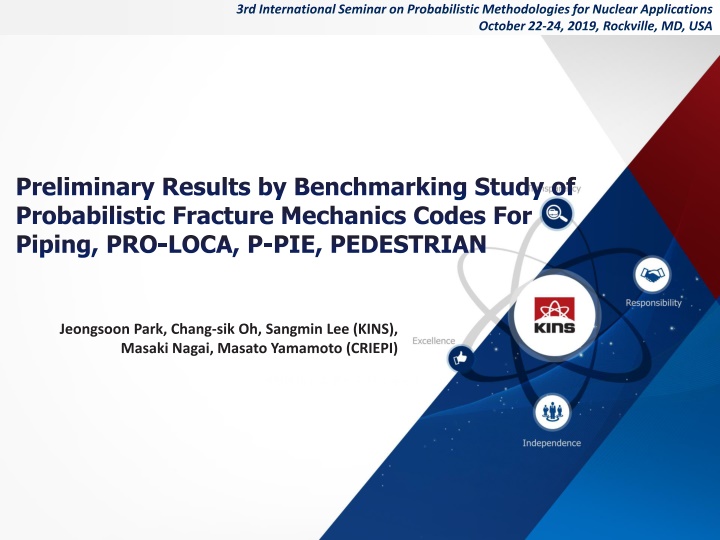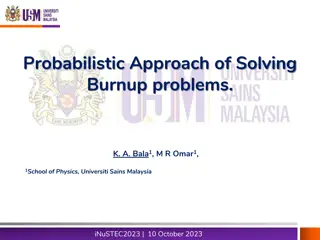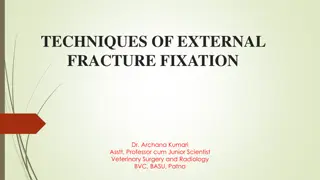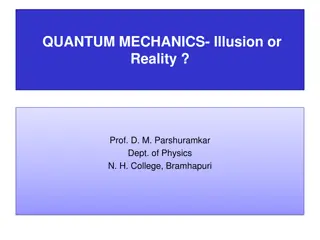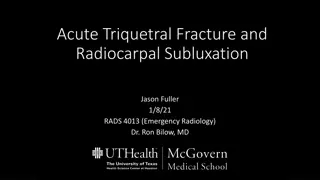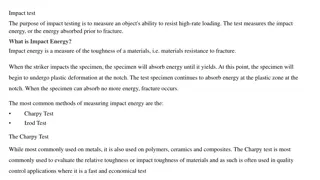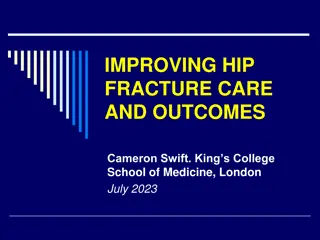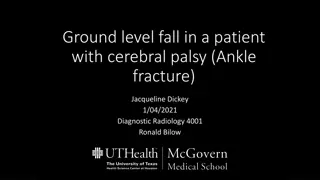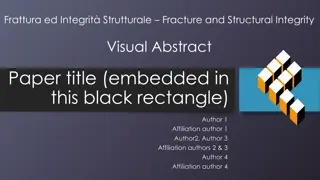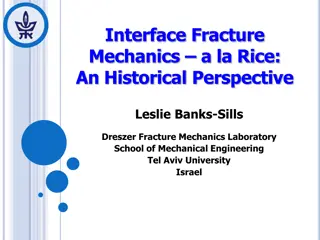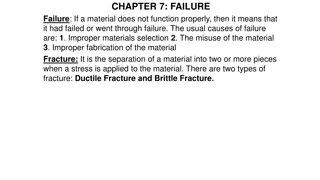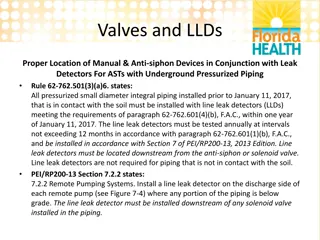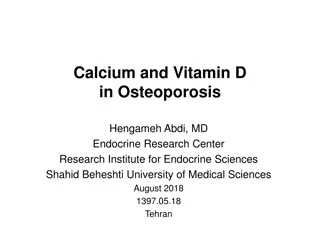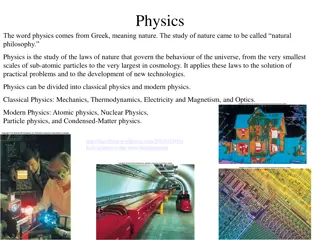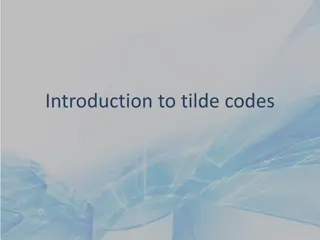Benchmarking Study of Probabilistic Fracture Mechanics Codes for Piping
This study presents the preliminary results of a benchmarking study on probabilistic fracture mechanics (PFM) codes for piping systems conducted by KINS and CRIEPI. The study aims to improve understanding, recommend best practices, and identify unexpected code behaviors for future enhancements. The project, part of the PARTRIDGE-3 program, involves utilizing codes like PRO-LOCA, as well as in-house codes P-PIE and PEDESTRIAN, to enhance regulatory tools for risk-informed decision-making in nuclear applications. The study focuses on crack growth mechanisms, benchmark problems, and a framework for the benchmark study.
Download Presentation

Please find below an Image/Link to download the presentation.
The content on the website is provided AS IS for your information and personal use only. It may not be sold, licensed, or shared on other websites without obtaining consent from the author.If you encounter any issues during the download, it is possible that the publisher has removed the file from their server.
You are allowed to download the files provided on this website for personal or commercial use, subject to the condition that they are used lawfully. All files are the property of their respective owners.
The content on the website is provided AS IS for your information and personal use only. It may not be sold, licensed, or shared on other websites without obtaining consent from the author.
E N D
Presentation Transcript
3rd International Seminar on Probabilistic Methodologies for Nuclear Applications October 22-24, 2019, Rockville, MD, USA Preliminary Results by Benchmarking Study of Probabilistic Fracture Mechanics Codes For Piping, PRO-LOCA, P-PIE, PEDESTRIAN Jeongsoon Park, Chang-sik Oh, Sangmin Lee (KINS), Masaki Nagai, Masato Yamamoto (CRIEPI) KINS
Contents Introduction II PWSCC Case III Fatigue Case IV Conclusions
Background PARTRIDGE-3 program Probabilistic Analysis as a Regulatory Tool for Risk-Informed Decision GuidancE-3 International cooperative project led by Battelle Membership: Japan (CRIEPI), Korea (KINS, KEPCO E&C, KHNP), Switzerland (PSI), Canada (CNSC), US (USNRC) Main objective: further development of PRO-LOCA Benchmarking study Two members of PARTRIDGE, CRIEPI and KINS has joined and launched a benchmarking study of probabilistic fracture mechanics (PFM) codes for piping. Utilized PFM codes: PRO-LOCA, in-house codes (P-PIE, PEDESTRIAN) 4
Objectives Improve participant s understanding about the PFM codes Set up some recommendations of best practices when applying the PFM codes for piping systems Find unexpected code behaviors of the PFM codes for future improvements of the codes 5
Benchmark Problems Crack Growth Mechanism Case Reference Paper PFM Codes used in Refs. Notes Circumferential crack + O-I WRS xLPR(V2.0) PVP2015-451341 1 PWSCC 2 w/o earthquake PRAISE-JNES PASCAL-SP IJPVP 117-118(2014), pp.56-632 Fatigue 3 with earthquake 1. D. Rudland, C. Harrington, D. Dingreville, Development of the Extremely Low Probability of Rupture (xLPR) Version 2.0 Code, PVP2015-45134, Proceedings of the ASME 2015 Pressure Vessels and Piping Division Conference, July 19-23, 2015, Boston, Massachusetts, USA. 2. J. Katsuyama, H. Itoh, Y. Li, K. Osakabe, K. Onizawa, S. Yoshimura, Benchmark Analysis on Probabilistic Fracture Mechanics Analysis Codes Concerning Fatigue Crack Growth in Aged Piping of Nuclear Power Plants, International Journal of Pressure Vessels and Piping 117-118, pp. 56-63, 2014 6
Framework of Benchmark Study Phase 1: Solve benchmark problems with no consideration for both crack and leak detection (on-going) Step 1: Generate inputs separately with each organization s understanding of the problems Step 2: Generate inputs based on common and best understanding of the problems Preliminary Results Future Works Phase 2: Solve benchmark problems with consideration for crack and/or leak detection. Probability of detection curves and leak detection capability will be defined for the benchmark problem. Phase 3: Sensitivity study for the benchmark problems Several case studies will be performed to study influence of selected input parameters. 7
PFM Codes PRO-LOCA (PRObabilistic Loss Of Coolant Accident) Initially developed for USNRC, circa 2003 Further developed as part of MERIT and PARTRIDGE programs The latest version: Version 6.2 (released Dec. 2018) Cracking mechanisms: SCC(PWSCC), Fatigue P-PIE (Piping Probabilistic Integrity Evaluation) Developed for KINS by Chungbuk National University in Korea Initially developed in 2010 based on PRAISE and further enhanced in 2013 Cracking mechanisms: SCC, Fatigue PEDESTRIAN (Probabilistic Evaluation and Deterministic Evaluation of Structural Integrity for Aging NPPs) Being developed by CRIEPI Cracking mechanisms: Fatigue, PWSCC(Being developed) 8
PFM Codes Comparison For a circumferential crack Feature P-PIE +from the publicly available documents PASCAL-SP+ xLPR+ PRO-LOCA PEDESTRIAN Monte Carlo Direct sampling with replacement Monte Carlo* DPD Importance Adaptive Monte Carlo LHS DPD Adaptive Sampling method Stratified Monte Carlo Stratified Monte Carlo Load Stress Force/Moment Stress Stress Force/Moment (Input type) PRAISE Raju &Newman Universal Weight Function Method Universal Weight Function Method JSME FFS (JSME S-NA1-2012) K-solution SCC(PWSCC included) Fatigue SCC(PWSCC beingincluded) Fatigue SCC(PWSCC included) Fatigue SCC(PWSCC included) Fatigue SCC Fatigue Crack growth TWC criterion a/t=1 a/t=0.95 a/t=0.75 Unknown a/t=0.95 EPFM(Z- factor)* Two parameter method Net-section collapse EPFM(Z- factor) Net-section collapse Min(EPFM- LBB.ENG2 or Net-section collapse) Min(EPFM- LBB.ENG2 or Net-section collapse) J-T* Net-section yielding TWC Failure criterion 9 * used in the benchmark study
PWSCC Case (Case 1) PRO-LOCA, P-PIE
Problem Definition Reference paper D. Rudland et al., Development of the extremely low probability of rupture(xLPR) version 2.0, PVP2015-45134 PWSCC problem (Case 1) PWR reactor pressure vessel outlet nozzle dissimilar metal (DM) weld Geometry: Diameter: 885.8 mm | Wall thickness: 66.7 mm Cracking mechanism: PWSCC (circumferential crack) MRP-263 PWSCC growth rate equation* * MRP-302, Models and inputs selected for use in the xLPR pilot study
Problem Definition (contd) PWSCC problem (Case 1) Load: Typical for Westinghouse four-loop reactor pressure vessel outlet nozzle DM weld Dead weight + Thermal expansion Normal operating condition: Pressure: 15.5 MPa | Temperature: 325 C Weld residual stress: O-I axial stress (ID max.: 380.83 MPa) O-I : OD repair followed by the ID repair
Input Summary for Reference Deterministic inputs Yield & ultimate strengths, elastic modulus of the base metals J-resistance curve exponent of the weld PWSCC growth parameters: Hydrogen, constant ( ), exponent ( ) Probabilistic inputs (distribution type) J-resistance curve, JIC(uniform) and constant (normal) of the weld Initial crack length (log-normal) and depth (log-normal) WRS (normal) Pressure (normal) Temperature (normal) PWSCC growth parameters Fweld(log-normal), Fww(log-normal), Q/R (normal), cw(normal), PR(normal) 13
Input Differences Unavoidable input differences due to each PFM code s characteristics Crack initiation time Weld residual stress PWSCC crack growth parameters Material properties Ramberg-Osgood parameters 14
Input Differences (contd) Crack Initiation Time Reference (xLPR) PRO-LOCA & P-PIE Initiation time is dependent on surface stress and temperature Distribution of initiation time is approximated to have the same initiation probability with the reference Log-normal distribution: mean(1163 month), s tandard deviation(1702 month) Initial Crack Size (Random variable) Half length: log-normal distribution (Mean: 3.3 mm | SD*: 0.31) Depth: log-normal distribution (Mean: 1.6 mm | SD: 0.06) *SD: standard deviation Weld Residual Stress (WRS) Reference (xLPR) & PRO-LOCA P-PIE O-I WRS distribution (26 data points through thickness of the weld) Linear distribution with the same ID WRS (252.3 MPa) 15
Input Differences (contd) PWSCC Crack Growth Rate Reference (xLPR) & PRO-LOCA P-PIE MRP-263 PWSCC crack growth rate model General SCC crack growth rate model ? = ? ?? ?? ? Random variables: activation energy (Qg), fweld, fww, Peak-to-valley ratio (PR), characteristic width (cw) The Coefficient C was analytically approximated by considering the MRP-263 crack growth parameters Lognormal distribution: mean (1.12E-12) | SD (7.81E-13) Deterministic variables: hydrogen concentration (H2), , MRP-263 PWSCC growth rate equation 16
Input Differences (contd) Ramberg-Osgood (R-O) Parameters PRO-LOCA Reference (xLPR) calculated internally using sampled yield and ultimate strengths User inputs (F, n) 1/? ? ??? 1? ? ? ?? =? ? ?? + ? ,? = ?? P-PIE User input( , n) Calculated in accordance with the PRO-LOCA manual 17
Results Initiation probabilities 1.E+00 1.E-01 Probability 1.E-02 Initiation_PRO-LOCA Initiation_PRO-LOCA 1.E-03 Initiation_P-PIE Initiation_P-PIE Initiation_Reference(xLPR) Initiation_Reference(xLPR) 1.E-04 0 100 200 300 Time (Month) 400 500 600 700 18
Results (contd) Through-wall crack (TWC) and rupture probabilities 1.E+00 1.E-01 Probability 1.E-02 TWC_PRO-LOCA TWC_PRO-LOCA TWC_P-PIE TWC_P-PIE TWC_Reference(xLPR) TWC_Reference(xLPR) 1.E-03 Rupture_PRO-LOCA Rupture_PRO-LOCA Rupture_P-PIE Rupture_P-PIE Rupture_Reference(xLPR) Rupture_Reference(xLPR) 1.E-04 0 100 200 300 Time (Month) 400 500 600 700 19
Summary Both PRO-LOCA and P-PIE predict higher TWC and rupture probabilities than the reference. Faster crack growth that results in similar TWC and rupture probabilities Possible causes Factors PRO-LOCA P-PIE xLPR Initial crack placement Based on stress/temperature Top dead end of the pipe Top dead end of the pipe - O-I distribution - might be interacted with the crack initiation model Linear distribution with the same ID WRS WRS O-I distribution General SCC growth law with the coefficient approximated analytically PWSCC crack growth law MRP-263 eq n MRP-263 eq n User input: calculated in accordance with the PRO- LOCA manual R-O R-O parameters determined internally User input parameters 20
Problem Definition Reference paper J. Katsuyama et al., Benchmark analysis on probabilistic fracture mechanics analysis codes concerning fatigue crack growth in aged piping of nuclear power plants, IJPVP 117-118, pp. 56-63, 2014 Fatigue problems BWR 300A Stainless Steel Diameter: 318.6 mm | Wall thickness: 17.4 mm Cracking mechanism: Fatigue (circumferential crack) Based on JSME Fitness-For-Service rules (JSME S NA1-2008) ?? ??0.5 ?3.0 1 ?2.12 (A crack is initiated at the beginning of the operating time) ?? ??= without earthquake (Case 2) With an earthquake (Case 3) Seismic stress: 150 MPa | Equivalent no. of cyclic stress: 60 22
Problem Definition (contd) Fatigue Problems Load: Normal operating loads + transient loads Internal pressure: 9 MPa Membrane stress: 66.9 MPa Transient stresses: Table 3 of the reference Weld residual stress ID max: about 439 MPa 500 400 300 Aixal Stress (MPa) 200 100 0 -100 -200 -300 23 0 0.2 0.4 0.6 0.8 1 x/thickness
Input Summary for Reference Deterministic inputs Pressure, Temperature Elastic modulus WRS Fatigue crack growth parameter: Exponent, rise time (tr) Probabilistic inputs (distribution type) Yield and ultimate strengths (log-normal) J-resistance curve, JIC(normal) and constant (normal) of the weld Initial crack length (log-normal) and depth (log-normal) Fatigue crack growth parameters Coefficient (log-normal) 24
Input Differences Unavoidable input differences due to each PFM code s characteristics Transients Weld residual stress Earthquake Fatigue crack growth rate Tensile properties (yield and ultimate strengths) J-resistance curve parameters 25
Input Differences (contd) Transients PRO-LOCA P-PIE & PEDESTRIAN Membrane and bending stresses of the reference were converted into moments. Axial force of the transient doesn t contributed to fatigue crack growth. Used the membrane and bending stresses from the reference. In the crack stability evaluation, (PEDESTRIAN) Only bending stresses of transients were considered. (P-PIE) In order to consider the effect of the transient stresses, the max. stress of the transients was added to the normal operating stress. In the crack stability evaluation, the max. moment was considered per transient. Weld Residual Stress (WRS) PRO-LOCA : WRS distribution from the reference (26 data point) PEDESTRIAN The reference WRS was approximated by a 3-order polynomial curve corresponding to the SIF solution given in the JSME FFS code. P-PIE: Linear distribution with the similar ID WRS (430 MPa) 26
Input Differences (contd) Earthquake (Case 3) PRO-LOCA P-PIE & PEDESTRIAN The seismic bending stress was converted to the moment, deterministic and static load. Only used in the crack stability evaluation (not contributed to the crack growth) Assumed to occur every month(evaluating time) The seismic bending stress with equivalent cycles of 60 were entered. Contributes to both the crack growth and crack stability evaluation Assumed to occur every year(evaluating time) After checking stability, reset to the crack size before the earthquake Fatigue Crack Growth Rate PRO-LOCA & PEDESTRIAN P-PIE C was analytically approximated based on Cf and tr Cf: log-normal distribution (median: 1.59E-1 2, SD of ln(Cf): 0.355) tr: rise time, 1000 s (deterministic) ??=?? ??0.5 ?3.0 Stress ratio R(Kmin/Kmax) was not considered. ?? ??= ? ?3.0 ?? 1 ?2.12 27
Input Differences (contd) Tensile Properties Reference (PASCAL-SP) & PEDESTRIAN PRO-LOCA Flow stress of stainless steel Log-normal distribution (median: 302 MPa, SD: 3.69E-2) For the crack stability evaluation, EPFM method with the Z factor are used. Yield and ultimate strengths are required (Flow stress is determined based on the sampled yield and ultimate strengths). Determined to have the same distribution type (log-normal) with similar mean and SD to the reference flow stress, using the type 304 stainless steel base metal properties from the pipe fracture encyclopedia. ??= ???+ ? ?? J-Resistance Curve Parameters Reference (PASCAL-SP) & PEDESTRIAN PRO-LOCA & P-PIE No need to input since the EPFM method with the Z factor was used for the crack stability evaluation Data that gives the highest mean value of JIc (stainless steel base metal) was selected from the pipe fracture encyclopedia. LB and UB were determined in accordance with the PRO-LOCA User s Manual. 28
Results (Case 2) Rupture probabilities 1.E+00 PRO-LOCA P-PIE PEDESTRIAN Reference(PASCAL-SP) 1.E-01 1.E-02 1.E-03 Probability 1.E-04 1.E-05 1.E-06 1.E-07 1.E-08 0 100 200 300 400 500 Time (Month) 29
Results (contd) (Cases 2 & 3) Rupture probabilities 1.E+00 PRO-LOCA P-PIE PEDESTRIAN Referemce(PASCAL-SP) PRO-LOCA (Case 2) P-PIE (Case 2) PEDESTRIAN (Case 2) Reference (Case 2) 1.E-01 1.E-02 PEDESTRIAN ~ 0 1.E-03 Probability PRO-LOCA 1.E-04 P-PIE Reference 1.E-05 1.E-06 1.E-07 1.E-08 0 100 200 300 400 500 Time (Month) 30
Summary PRO-LOCA, P-PIE, and PEDESTRIAN show higher rupture probabilities than the reference, especially at the beginning. Implicating the effect of crack growth due to transients on rupture is small. Trends of the rupture probabilities between the 3 PFM codes are similar. 31
Summary (contd) Possible causes Factors PRO-LOCA P-PIE PEDESTRIAN TWC criterion a/t=0.95 a/t=1.0 a/t=0.75 Crack stability (TWC failure) criteria Min(EPFM(LBB.ENG2) or Net- section collapse) EPFM(J-T) EPFM with Z-factor Determined to have the similar flow stress to the reference Determined to have the similar flow stress to the reference Flow stress from the reference YS, US Highest J-R from the database for stainless steel base metal Highest J-R from the database for stainless steel base metal J-R Not used Coefficient of the FCG law was analytically approximated (w/o stress ratio) Fatigue crack growth law FCG law from the reference FCG law from the reference 3rdorder polynomial curve fit Distribution from the reference Linear distribution with the similar ID WRS WRS 32
Summary (contd) Possible causes Factors PRO-LOCA P-PIE PEDESTRIAN Transients Yes Yes Crack growth contribution Yes (Membrane and bending stresses) (Membrane and bending stresses) (Only Moments) No Crack stability contribution Yes (But modified in input to consider the max. stress in the transients) Yes (Only moments) (Only bending stress) Earthquake Yes Yes Crack growth contribution (Reset the crack size after checking crack stability due to earthquake) (Reset the crack size after checking crack stability due to earthquake) No Crack stability contribution Yes Yes Yes 33
Conclusions Two member organizations of the PARTRIDGE program have conducted the benchmark study by using the PFM codes for piping, PRO-LOCA, P-PIE and PEDESTRIAN. The benchmark problems (PWSCC and Fatigue cases) were defined based on the published papers which utilized other PFM codes, xLPR and PASCAL-SP. The 3 PFM codes show similar trends of resultant TWC and rupture probabilities for the benchmark problems. but predict different trend and higher probabilities than the references. Further research and sensitivity studies will be continued during the remaining phases of the benchmark study. 35
Acknowledgement The authors would like to thank Dr. D. Rudland from USNRC and Dr. J. Katsuyama for providing valuable information about their research referenced in this benchmarking study. The authors would like to acknowledge other organizations (KEPCO E&C and KHNP-CRI) of the Korean Consortium for the PARTRIDGE program for their support and valuable comments on the benchmarking study. 36
